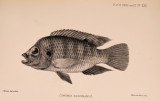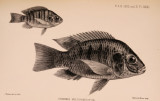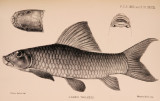| OCR Text |
Show 288 MR. C. TATE REGAN ON [Nov. 4, line. Dorsal with Y -Y I spines. Soft dorsal and anal rather shorter than in Triacanthus ; ventrals usually with one or two rudimentary soft rays; caudal rounded. Jaws with a series of conical teeth, and usually a few inner teeth. Hollardia Poey seems not distinct from this genus. 3. H a l im o c h i r u r g u s Alcock.-Body low, compressed, with short caudal peduncle. Scales small, spinate. No lateral line. Snout much produced, lower jaw projecting. D. II, 13; A. 12. Ventrals without soft rays. Caudal rounded. Teeth very small, conical, in a single series. Family 2. T riodontid.e. Prcecaudal vertebrae without parapophyses ; epipleurals well-developed. Premaxillaries not protractile, firmly united to the maxillaries; teeth in the jaws coalescent. Pelvis represented by a single long bone, movably attached to the pectoral arch. No spinous dorsal; soft dorsal and anal short; no ventrals. Abdomen with a dilatable sac, kept expanded by the movable pelvis; lower part of sac a flap of skin into which the air does not enter. In other characters like the Triacanthidae. Genus. T riodon.- Body compressed, caudal peduncle long and slender. Scales osseous. Caudal forked, with 18 rays. Twenty vertebrae. Although unable to examine a skeleton of this genus, a study of the figures and descriptions published has convinced me that the skull, vertebral column, and pectoral arch are extremely like those of Triacanthus, whilst the scales, movable pelvis, ventral sac and flap are similar to those of the Balistidae. The only features which link this family to the Tetrodontidae, in the neighbourhood of which it has generally been placed, are the comparatively unimportant characters of the coalesced teeth and absent spinous dorsal. It would be interesting to know whether the fourth upper pharyngeals are well-developed and toothed, as in Triacanthus, or rudimentary and toothless, as in Balisles. Family 3. B alistidae. Prsecaudal vertebrae with well developed parapophyses to which epipleurals are attached. Praeorbital more or less ossified. Ethmoid region long, without distinct nasal cavities. Palatine movably articulated with ectopterygoid, or else entirely free from it. Premaxillaries not protractile, firmly united to the maxillaries. Fourth upper pharyngeals rudimentary, not toothed. Incisor-like teeth in the jaws. Pelvis long, movable. Spinous dorsal with one to three spines, the first, if strong, followed by a second which locks it when erected. Soft dorsal and anal long or of moderate length. Ventrals. if present, represented by a single |
































































































































































































































































































































